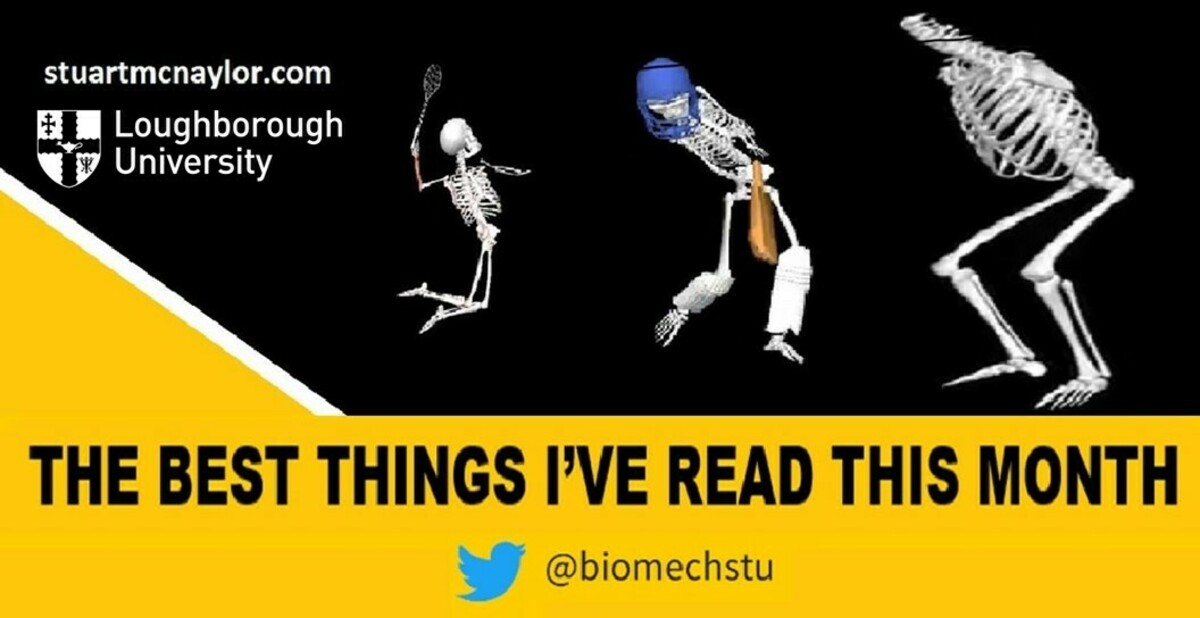
Happy new year! I hope you had an enjoyable end to 2021, and that 2022 brings you everything you deserve.
One of my goals for 2022 is to grow this newsletter from the current 292 readers. So if you think anybody else would enjoy the monthly round up of articles and resources, I would really appreciate it if you could share this link with them.
Here’s what I would like to share with you this month…
There are two sections: ‘What Have I Been Up To?’ and ‘What Have I Been Reading?’
What Have I Been Up To?
A look back at 2021: I posted a Twitter thread summarising our research from the past year. This included open access links to all articles and thread summaries of the individual papers. Topics covered included simulation modeling, post-impact accelerations, countermovement jumps, cricket batting, and flywheel resistance exercise (I should probably narrow my research focus in 2022!).
Conferences in 2022: The schedule for the ISBS Mid Year Symposium was recently announced. This includes 16 online sessions of sports biomechanics over 2 days, and it’s free for ISBS members. I’m looking forward to presenting as part of the student event, on “Starting small: Resources and up-skilling in sports biomechanics”. Abstract submission is also currently open for the 2022 annual conference to be held in July in Liverpool, UK.
Video lectures: I presented at Nottingham Trent University’s SHAPE Seminar Series on “understanding the effects of impact location in racket or bat sports”. A version of the presentation is available below. This month also saw two more additions to my Science of Cricket series on YouTube. Alex Lascu presented on skill acquisition, and Pete Alway presented on the lumbar spine in fast bowlers. The series continues this month.
What Have I Been Reading?
Now for the main part of the newsletter…
21 lessons learned in 2021: This newsletter by Sahil Bloom was fantastic. Full of easily digestible, actionable lessons, each with a short explanation and mini visualisation.
Read your work out loud: When proof reading your work, do you read it out loud or in your head? This excellent thread by Nicolas Cole argues that you should read it out loud. He even goes as far as to say that “Reading your writing out loud is the most important part of becoming a great writer”. It’s difficult to argue with some of the points made, and definitely worth giving it a go if you don’t already.
Randomised controlled trials of parachute use? Yes, you read that correctly. Before I get into the journal articles, I thought I’d start with a more humerous one. I’d been meaning to read this for a while, and it didn’t disappoint. When should we make decisions on the use of a particular intervention based on observational data and when should we require randomised controlled trials? I enjoyed the way this was presented, particularly the tongue-in-cheek suggestion that the most radical protagonists of evidence based medicine should participate “in a double blind, randomised, placebo controlled, crossover trial of the parachute”.
Award winning papers: Sports Biomechanics recently published review articles from the last two winners of the ISBS Hans Gros Emerging Researcher Award. 2020 winner, Gillian Weir, reviewed biomechanically informed approaches to ACL injury prevention in sport. Her award lecture on this topic can be seen here . 2021 winner, Gregory Tierney, reviewed the literature around concussion biomechanics in sport.
Average models produce non-average results: Simulation models using average input parameters from a population are often used to investigate particular research questions with regards to that population of interest. But do these average inputs actually produce results that are representative of the population average output? This study put that to the test, reporting that average models did not produce average results. The authors called this the “Generic Modeling Fallacy”, providing detailed explanations and examples.
Sample size justifications: The journal Gait & Posture recently introduced a requirement for sample size justification within their author guidelines. But what difference did it make? This article compares studies conducted before and after the change in guidelines, presenting a detailed analysis of the types of justification used (if any).
Historical women in mechanics: An important one to finish on. Two posts on Twitter caught my attention recently, both about historical women I had never heard of in mechanics. The first was Émilie du Châtelet, who not only translated the work of Sir Isaac Newton but added clarity, examples, derivatives, and even an original conservation law for total energy that emphasised the role of kinetic energy. The second was E.A. Kotikova, possibly the first ever sports biomechanist. This short thread on her contributions is well worth a read. Thank you to PJ Vazel for raising awareness.
Thank You
That’s all for this month. If you found it useful, please forward this email or share this link with friends, colleagues, or on social media.
What Have You Read Recently?
If you’ve read anything particularly interesting or useful recently, please reply to this email and let me know. I read all of the replies and I’m always looking for good reading suggestions.
Take care, and thank you for reading. I hope you have a great January!
Stuart